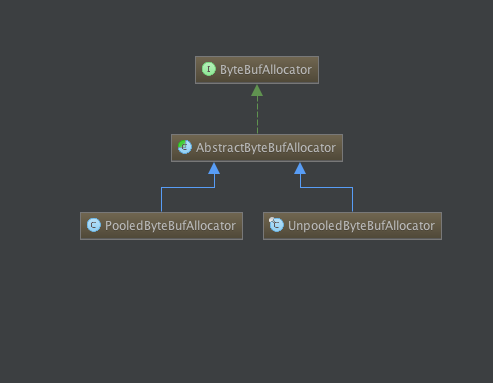Netty 学习系列四:读操作
一、缓存空间分配器:ByteBufAllocator
ByteBufAllocator接口为ByteBuf分配器,用于分配新的ByteBuf存储IO数据。

1、ByteBufAllocator
接口定义了 ByteBuf ioBuffer(int initialCapacity) 方法,用于分配一个ByteBuf
2、AbstractByteBufAllocator
实现了ByteBuf ioBuffer(int initialCapacity)方法,根据系统配置实际调用自己的抽象方法
ByteBuf newDirectBuffer(int initialCapacity,int maxCapacity); ByteBuf newHeapBuffer(int initialCapacity,int maxCapacity);
其子类UnpooledByteBufAllocator和PooledByteBufAllocator实现了上述抽象方法。
3、UnpooledByteBufAllocator
非池化的ByteBuf分配器,具体实现了抽象方法。
1)对于newDirectBuffer
根据平台是否支持Unsafe方式,将实例化出一个UnpooledDirectByteBuf/UnpooledUnsafeDirectByteBuf。
UnpooledDirectByteBuf是一个基于NIO的Buffer,其内部持有一个NIO ByteBuffer buffer,并通过ByteBuffer.allocateDirect(initcapacity)方法进行实例化。
2)对于newHeapBuffer
根据平台是否支持Unsafe方式,将实例化出一个UnpooledHeapByteBuf/UnpooledUnsafeHeapByteBuf。
UnpooledHeapByteBuf是一个基于java heap的Buffer,其内部直接在java heap中申请byte[] array空间进行IO数据存储。
二、接收缓存分配器:RecvByteBufAllocator
1、接口概述
RecvByteBufAllocator接口用于分配一块大小合理的buffer空间,存储Channel读入的IO数据。具体功能交由内部接口Handle定义。
interface Handle {
/**
* Creates a new receive buffer whose capacity is probably large enough to read all inbound data and small
* enough not to waste its space.
*/
ByteBuf allocate(ByteBufAllocator alloc);
/**
* Increment the number of messages that have been read for the current read loop.
* numMessages The amount to increment by.
*/
void incMessagesRead(int numMessages);
/**
* Set the bytes that have been read for the last read operation.
* This may be used to increment the number of bytes that have been read.
* bytes The number of bytes from the previous read operation. This may be negative if an read error
* occurs. If a negative value is seen it is expected to be return on the next call to
* #lastBytesRead()}. A negative value will signal a termination condition enforced externally
* to this class and is not required to be enforced in #continueReading()}.
*/
void lastBytesRead(int bytes);
/**
* Determine if the current read loop should should continue.
* true} if the read loop should continue reading. false} if the read loop is complete.
*/
boolean continueReading();
/**
* The read has completed.
*/
void readComplete();
}
allocate(ByteBufAllocator alloc)方法用于创建存放读入IO数据的ByteBuf。
readComplete()在读操作完成后调用,在实现类HandleImpl中执行record(int actualReadBytes)做了调整分配空间大小的逻辑。
2、实现类AdaptiveRecvByteBufAllocator
接口RecvByteBufAllocator的实现类,能根据前一次实际读取的字节数量,自适应调整当前缓存分配的大小。
三、NioEventLoop处理OP_READ事件
1、代码入口
private void processSelectedKey(SelectionKey k, AbstractNioChannel ch) {
//上面省略...
if ((readyOps & (SelectionKey.OP_READ | SelectionKey.OP_ACCEPT)) != 0 || readyOps == 0) {
unsafe.read();
if (!ch.isOpen()) {
// Connection already closed - no need to handle write.
return;
}
}
//下面省略...
}
NioEventLoop在处理其selector监听到的OP_READ事件时,会执行上面的代码逻辑,将OP_READ事件最终交由Unsafe处理,即执行NioByteUnsafe.read()方法。
public final void read() {
final ChannelConfig config = config();
final ChannelPipeline pipeline = pipeline();
final ByteBufAllocator allocator = config.getAllocator();
final RecvByteBufAllocator.Handle allocHandle = recvBufAllocHandle();
allocHandle.reset(config);
ByteBuf byteBuf = null;
boolean close = false;
try {
do {
byteBuf = allocHandle.allocate(allocator);
allocHandle.lastBytesRead(doReadBytes(byteBuf));
if (allocHandle.lastBytesRead() <= 0) {
// nothing was read. release the buffer.
byteBuf.release();
byteBuf = null;
close = allocHandle.lastBytesRead() < 0;
break;
}
allocHandle.incMessagesRead(1);
readPending = false;
pipeline.fireChannelRead(byteBuf);
byteBuf = null;
} while (allocHandle.continueReading());
allocHandle.readComplete();
pipeline.fireChannelReadComplete();
if (close) {
closeOnRead(pipeline);
}
} catch (Throwable t) {
handleReadException(pipeline, byteBuf, t, close, allocHandle);
} finally {
// Check if there is a readPending which was not processed yet.
// This could be for two reasons:
// * The user called Channel.read() or ChannelHandlerContext.read() in channelRead(...) method
// * The user called Channel.read() or ChannelHandlerContext.read() in channelReadComplete(...) method
//
// See https://github.com/netty/netty/issues/2254
if (!readPending && !config.isAutoRead()) {
removeReadOp();
}
}
}
2、执行逻辑
1)获取缓存分配器
final ByteBufAllocator allocator = config.getAllocator(); final RecvByteBufAllocator.Handle allocHandle = recvBufAllocHandle();
循环执行以下逻辑直到跳出--->
2)分配缓存ByteBuf
ByteBuf byteBuf = allocHandle.allocate(allocator);
3)将数据从nio.SocketChannel读取到byteBuf中
doReadBytes(byteBuf)
实际调用了NioSocketChannel.doReadBytes(ByteBuf byteBuf)方法。
进一步调用ByteBuf.writeBytes(ScatteringByteChannel in, int length)方法。
最终底层调用nio的ReadableByteChannel.read(ByteBuffer dst)方法。
if (allocHandle.lastBytesRead() <= 0) {
// nothing was read. release the buffer.
byteBuf.release();
byteBuf = null;
close = allocHandle.lastBytesRead() < 0;
break;
}
若本次读取到的数据长度==0,表示本次OP_READ事件的数据已读取完毕,退出循环。
若本次读取到的数据长度<0,表示对端已断开socket连接,退出循环,执行NioByteUnsafe.closeOnRead()方法关闭Channel,关闭Channel的过程中执行了pipeline.fireChannelInactive()和pipeline.fireChannelUnregistered()。
4)触发ChannelRead事件,将读ByteBuf交给pipeline流转
pipeline.fireChannelRead(byteBuf); byteBuf = null;
<----循环结束。结束条件:a、localReadAmount == 0或-1,b、循环读取到ByteBuf个数超过指定阈值
5)根据本次已读字节数,调整RecvByteBufAllocator的下次分配的缓存大小
allocHandle.readComplete();
6)触发ChannelReadComplete事件
pipeline.fireChannelReadComplete();











![[HBLOG]公众号](https://www.liuhaihua.cn/img/qrcode_gzh.jpg)

